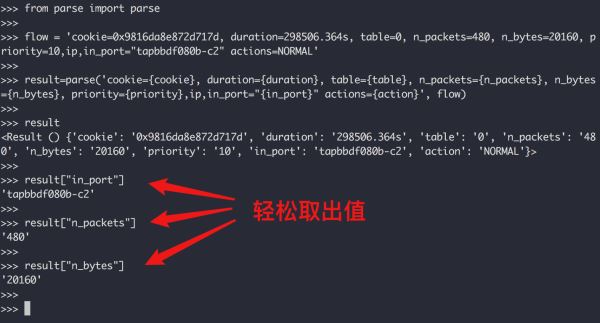您好,登錄后才能下訂單哦!
您好,登錄后才能下訂單哦!
這篇文章主要介紹“如何使用不需要用到正則的Python文本解析庫parse”,在日常操作中,相信很多人在如何使用不需要用到正則的Python文本解析庫parse問題上存在疑惑,小編查閱了各式資料,整理出簡單好用的操作方法,希望對大家解答”如何使用不需要用到正則的Python文本解析庫parse”的疑惑有所幫助!接下來,請跟著小編一起來學習吧!
拿一個最近使用 parse 的真實案例來舉例說明。
下面是 ovs 一個條流表,現在我需要收集提取一個虛擬機(網口)里有多少流量、多少包流經了這條流表。也就是每個 in_port 對應的 n_bytes、n_packets 的值 。
cookie=0x9816da8e872d717d, duration=298506.364s, table=0, n_packets=480, n_bytes=20160, priority=10,ip,in_port="tapbbdf080b-c2" actions=NORMAL
如果是你,你會怎么做呢?
先以逗號分隔開來,再以等號分隔取出值來?
你不防可以嘗試一下,寫出來的代碼應該和我想象的一樣,沒有一絲美感而言。
我來給你展示一下,我是怎么做的?

可以看到,我使用了一個叫做 parse 的第三方包,是需要自行安裝的
$ python -m pip install parse
從上面這個案例中,你應該能感受到 parse 對于解析規范的字符串,是非常強大的。
parse 的結果只有兩種結果:
1.沒有匹配上,parse 的值為None
>>> parse("halo", "hello") is None
True
>>>如果匹配上,parse 的值則 為 Result 實例
>>> parse("hello", "hello world")
>>> parse("hello", "hello")
<Result () {}>
>>>如果你編寫的解析規則,沒有為字段定義字段名,也就是匿名字段, Result 將是一個 類似 list 的實例,演示如下:
>>> profile = parse("I am {}, {} years old, {}", "I am Jack, 27 years old, male")
>>> profile
<Result ('Jack', '27', 'male') {}>
>>> profile[0]
'Jack'
>>> profile[1]
'27'
>>> profile[2]
'male'而如果你編寫的解析規則,為字段定義了字段名, Result 將是一個 類似 字典 的實例,演示如下:
>>> profile = parse("I am {name}, {age} years old, {gender}", "I am Jack, 27 years old, male")
>>> profile
<Result () {'gender': 'male', 'age': '27', 'name': 'Jack'}>
>>> profile['name']
'Jack'
>>> profile['age']
'27'
>>> profile['gender']
'male'和使用 re 一樣,parse 同樣支持 pattern 復用。
>>> from parse import compile
>>>
>>> pattern = compile("I am {}, {} years old, {}")
>>> pattern.parse("I am Jack, 27 years old, male")
<Result ('Jack', '27', 'male') {}>
>>>
>>> pattern.parse("I am Tom, 26 years old, male")
<Result ('Tom', '26', 'male') {}>從上面的例子中,你應該能注意到,parse 在獲取年齡的時候,變成了一個"27" ,這是一個字符串,有沒有一種辦法,可以在提取的時候就按照我們的類型進行轉換呢?
你可以這樣寫。
>>> from parse import parse
>>> profile = parse("I am {name}, {age:d} years old, {gender}", "I am Jack, 27 years old, male")
>>> profile
<Result () {'gender': 'male', 'age': 27, 'name': 'Jack'}>
>>> type(profile["age"])
<type 'int'>除了將其轉為 整型,還有其他格式嗎?
內置的格式還有很多,比如
匹配時間
>>> parse('Meet at {:tg}', 'Meet at 1/2/2011 11:00 PM')
<Result (datetime.datetime(2011, 2, 1, 23, 0),) {}>更多類型請參考官方文檔:
| Type | Characters Matched | Output |
|---|---|---|
| l | Letters (ASCII) | str |
| w | Letters, numbers and underscore | str |
| W | Not letters, numbers and underscore | str |
| s | Whitespace | str |
| S | Non-whitespace | str |
| d | Digits (effectively integer numbers) | int |
| D | Non-digit | str |
| n | Numbers with thousands separators (, or .) | int |
| % | Percentage (converted to value/100.0) | float |
| f | Fixed-point numbers | float |
| F | Decimal numbers | Decimal |
| e | Floating-point numbers with exponent e.g. 1.1e-10, NAN (all case insensitive) | float |
| g | General number format (either d, f or e) | float |
| b | Binary numbers | int |
| o | Octal numbers | int |
| x | Hexadecimal numbers (lower and upper case) | int |
| ti | ISO 8601 format date/time e.g. 1972-01-20T10:21:36Z (“T” and “Z” optional) | datetime |
| te | RFC2822 e-mail format date/time e.g. Mon, 20 Jan 1972 10:21:36 +1000 | datetime |
| tg | Global (day/month) format date/time e.g. 20/1/1972 10:21:36 AM +1:00 | datetime |
| ta | US (month/day) format date/time e.g. 1/20/1972 10:21:36 PM +10:30 | datetime |
| tc | ctime() format date/time e.g. Sun Sep 16 01:03:52 1973 | datetime |
| th | HTTP log format date/time e.g. 21/Nov/2011:00:07:11 +0000 | datetime |
| ts | Linux system log format date/time e.g. Nov 9 03:37:44 | datetime |
| tt | Time e.g. 10:21:36 PM -5:30 | time |
去除兩邊空格
>>> parse('hello {} , hello python', 'hello world , hello python')
<Result (' world ',) {}>
>>>
>>>
>>> parse('hello {:^} , hello python', 'hello world , hello python')
<Result ('world',) {}>去除左邊空格
>>> parse('hello {:>} , hello python', 'hello world , hello python')
<Result ('world ',) {}>去除右邊空格
>>> parse('hello {:<} , hello python', 'hello world , hello python')
<Result (' world',) {}>Parse 默認是大小寫不敏感的,你寫 hello 和 HELLO 是一樣的。
如果你需要區分大小寫,那可以加個參數,演示如下:
>>> parse('SPAM', 'spam')
<Result () {}>
>>> parse('SPAM', 'spam') is None
False
>>> parse('SPAM', 'spam', case_sensitive=True) is None
True精確匹配:指定最大字符數
>>> parse('{:.2}{:.2}', 'hello') # 字符數不符
>>>
>>> parse('{:.2}{:.2}', 'hell') # 字符數相符
<Result ('he', 'll') {}>模糊匹配:指定最小字符數
>>> parse('{:.2}{:2}', 'hello')
<Result ('h', 'ello') {}>
>>>
>>> parse('{:2}{:2}', 'hello')
<Result ('he', 'llo') {}>若要在精準/模糊匹配的模式下,再進行格式轉換,可以這樣寫
>>> parse('{:2}{:2}', '1024')
<Result ('10', '24') {}>
>>>
>>>
>>> parse('{:2d}{:2d}', '1024')
<Result (10, 24) {}>Parse 里有三個非常重要的屬性
fixed:利用位置提取的匿名字段的元組named:存放有命名的字段的字典spans:存放匹配到字段的位置
下面這段代碼,帶你了解他們之間有什么不同
>>> profile = parse("I am {name}, {age:d} years old, {}", "I am Jack, 27 years old, male")
>>> profile.fixed
('male',)
>>> profile.named
{'age': 27, 'name': 'Jack'}
>>> profile.spans
{0: (25, 29), 'age': (11, 13), 'name': (5, 9)}
>>>匹配到的字符串,會做為參數傳入對應的函數
比如我們之前講過的,將字符串轉整型
>>> parse("I am {:d}", "I am 27")
<Result (27,) {}>
>>> type(_[0])
<type 'int'>
>>>其等價于
>>> def myint(string):
... return int(string)
...
>>>
>>>
>>> parse("I am {:myint}", "I am 27", dict(myint=myint))
<Result (27,) {}>
>>> type(_[0])
<type 'int'>
>>>利用它,我們可以定制很多的功能,比如我想把匹配的字符串弄成全大寫
>>> def shouty(string):
... return string.upper()
...
>>> parse('{:shouty} world', 'hello world', dict(shouty=shouty))
<Result ('HELLO',) {}>
>>>到此,關于“如何使用不需要用到正則的Python文本解析庫parse”的學習就結束了,希望能夠解決大家的疑惑。理論與實踐的搭配能更好的幫助大家學習,快去試試吧!若想繼續學習更多相關知識,請繼續關注億速云網站,小編會繼續努力為大家帶來更多實用的文章!
免責聲明:本站發布的內容(圖片、視頻和文字)以原創、轉載和分享為主,文章觀點不代表本網站立場,如果涉及侵權請聯系站長郵箱:is@yisu.com進行舉報,并提供相關證據,一經查實,將立刻刪除涉嫌侵權內容。